The world of digital building directories is brimming with possibilities—static screens, rotating slides, interactive touchscreens, wall mounts, floor-standing kiosks, and even advanced features like 3D mapping or mobile integration. For businesses ready to move beyond outdated paper or strip directories, the sheer variety can feel overwhelming. Where do you even begin?
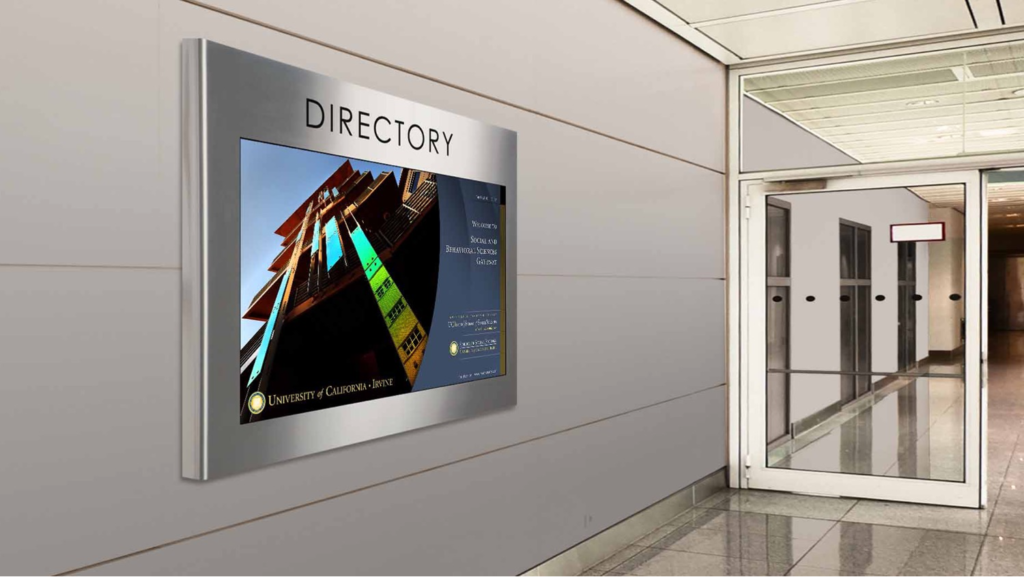
At REDYREF, we’ve helped countless clients navigate this decision, and we’ve learned that it all boils down to finding the right fit for your unique needs. To simplify the process, let’s break it down with a focus on two main options—touch vs. non-touch digital directories—and explore how the “three Ss” (Situation, Setting, and Surroundings) can guide your choice. Whether you’re outfitting an airport, a medical campus, or a high-rise apartment lobby, here’s what you need to know to make an informed decision.
Touch vs. Non-Touch: What’s the Difference?
First, the basics. Non-touch digital directories come in two flavors:
- Static: A fixed display showing consistent info, like office numbers or tenant locations.
- Rotating: A screen cycling through pre-set “slides” of information, with sections or the entire display updating automatically.
Touchscreen directories, on the other hand, bring interactivity to the table. These range from:
- Limited touch: Simple one- or two-button controls to page through screens or return to “home.”
- Fully interactive: Tablet-like capabilities with advanced software, enabling personalized wayfinding, searches, or custom features.
While touchscreens might seem like the obvious winner with their versatility, the best choice hinges on your specific environment. That’s where the “three Ss” come in.
The Three Ss: Your Decision-Making Framework
-
Situation: What’s the Purpose?
The “why” behind your directory shapes everything. If you’re an airport displaying flight info for hundreds of travelers at once, a large, non-touch rotating screen is ideal—readable from a distance, cost-effective, and no interactivity needed. Contrast that with a sprawling medical campus, where patients and visitors need tailored directions across multiple buildings. Here, smaller, full-touchscreen kiosks offering detailed interactive wayfinding outshine static displays by delivering a frustration-free, personalized experience.
Somewhere in between? Consider limited-touch options—like the headrest screens on airplanes. Passengers can page through entertainment options without needing full interactivity, balancing function and cost.
-
Setting: Where’s It Going?
The environment itself matters. A 40-floor apartment building in NYC might only need a compact touchscreen (under 26”) for tenants to scroll through names—basic yet effective. Add premium features like local maps or building announcements, and it’s still manageable. But a mixed-use development with shops, restaurants, and residences demands more: a fully interactive kiosk that lets users buy movie tickets, make reservations, or plan multi-stop routes.
For a hospital campus, ADA compliance and ease of use are non-negotiable. Patients—often stressed or short on time—benefit from touchscreen wayfinding that’s intuitive and calming, far beyond what a static floor-by-floor directory can offer.
-
Surroundings: Where’s It Placed?
Placement within the space seals the deal. A small office with 15 tenants can thrive with a wall-mounted, static non-touch directory—all the info fits on one screen, no bells or whistles required. Scale up to a larger facility with dozens of tenants or added functionality (like a digital receptionist), and a freestanding touchscreen kiosk becomes the smarter pick for accessibility and engagement.
In a staffed lobby, a desk-mount interactive directory can lighten the load on receptionists during peak hours, letting visitors self-serve while still having help nearby. For a high-rise apartment with 100+ residents, a floor-mounted unit with limited touch (scrolling and buzzing in guests) strikes the perfect balance.
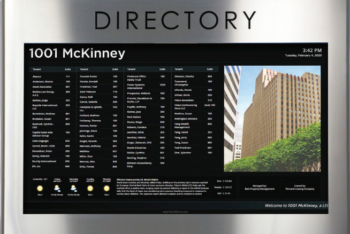
Why It Matters—and Why REDYREF Excels
Choosing between touch and non-touch isn’t just about features; it’s about maximizing value for your business and your users. A poorly matched directory can frustrate customers, waste resources, or miss opportunities to impress. That’s why we at REDYREF emphasize careful planning around the “three Ss”—it’s the key to unlocking a solution that works today and scales tomorrow.
As an end-to-end manufacturer of self-service kiosks, we’ve deployed digital directories for every imaginable scenario—from sleek office lobbies to bustling airports. Our clients, including industry leaders like Hilton and AT&T, trust us to deliver best-in-class experiences backed by ISO 9001:2015-certified quality. Whether you need a simple static display or a fully immersive wayfinding hub, we’ve got the expertise to make it happen.
Ready to Find Your Perfect Fit?
Investing in a digital directory doesn’t have to be daunting. Start with the “three Ss,” and let REDYREF guide you the rest of the way. Submit a request for proposal online or call us at (800) 628-3603 today to explore how our interactive kiosk solutions can elevate your space—and your customer experience. The future of wayfinding is here—let’s build it together.
While traditional printed, handwritten, or analog building directories still have a place in some spaces, the shift to digital directories and wayfinding solutions has gained significant traction over the past decade. With advancements in technology making these solutions more affordable, even small businesses are adopting digital directories to enhance the visitor experience and streamline operations.
If you’re considering making the switch, it’s natural to feel overwhelmed. A successful digital directory rollout requires thoughtful planning, from design and engineering to software development and deployment. But with the right partner, you can create a solution that meets the needs of both your business and your end users while avoiding common pitfalls.
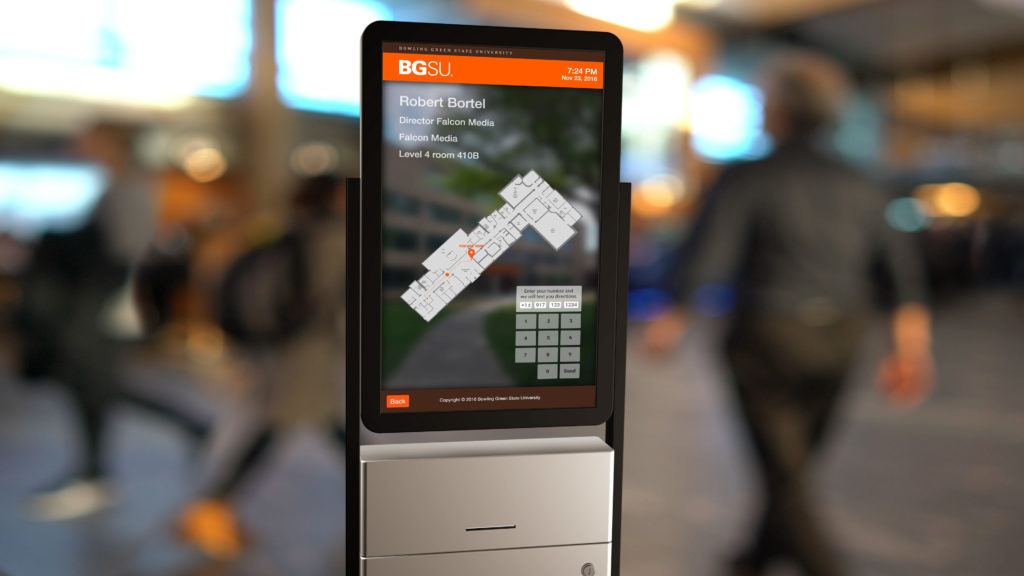
Why Go Digital? The Key Benefits
1. Effortless Updates:
One of the biggest frustrations with traditional directories is the time and effort required to update them. Digital and interactive directories allow for real-time updates, ensuring information is always accurate and relevant.
2. Improved Accessibility:
Digital directories can integrate features like multilingual support, audio guidance, or enhanced visual clarity, making them more inclusive for all users, including those with disabilities.
3. Enhanced User Experience:
With interactive touchscreens and intuitive interfaces, digital directories provide an effortless way for visitors to find what they need quickly, whether it’s a specific office, department, or amenity.
4. Space for More Information:
Digital solutions can display more information than a static directory. From real-time event schedules to detailed interactive wayfinding maps, digital directories offer unmatched flexibility.
5. Branding Opportunities:
A sleek, modern digital directory reinforces your company’s brand image and can even display promotional content or advertising, creating additional revenue streams.
Choosing the Right Partner for Your Digital Directory
Selecting a partner to bring your digital directory to life is one of the most important decisions you’ll make in this process. Look for a provider with end-to-end capabilities, including design, engineering, fabrication, and directory and wayfinding software development. This vertical integration eliminates the need to juggle multiple vendors and minimizes the risk of miscommunication, saving both time and money.
A fully integrated partner, like REDYREF, simplifies project management by serving as a single point of contact. From initial concept to final deployment, every step is handled in-house, ensuring efficiency and accountability.
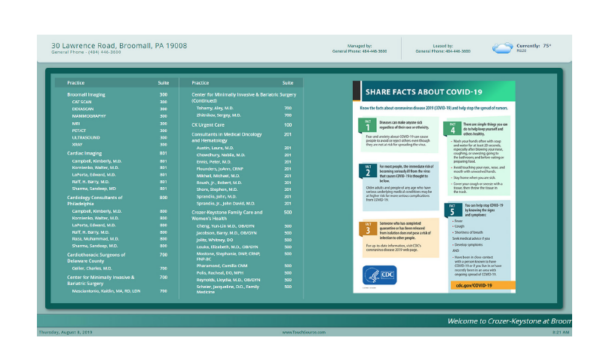
A Collaborative Process for a Tailored Solution
Before the design process even begins, your kiosk partner should work closely with you to understand the unique needs of your business and your users. Key questions might include:
•What are the main challenges with your current directory system?
•Are frequent updates causing delays or logistical issues?
•What specific information is most valuable to end users?
•How do users interact with the directory now, and what features would improve their experience?
This collaborative approach ensures that the final design is not only functional but also highly intuitive for users. The result? A solution that enhances the user experience while addressing your business challenges.
From Concept to Completion: The REDYREF Advantage
With REDYREF’s vertically integrated kiosk manufacturing process, your digital directory goes through every stage of development under one roof. Here’s what you can expect:
•Custom Design: A team of industrial designers and engineers works to create a solution tailored to your needs.
•Fabrication: Components are produced using state-of-the-art techniques, ensuring durability and precision.
•Finishing Touches: From powder coating to custom branding wraps, every detail is fine-tuned.
•Hardware Integration: Cutting-edge components like touchscreens, NFC payment systems, and printers can be seamlessly incorporated.
•Custom Software Development: REDYREF’s in-house team ensures your directory operates smoothly with features that align with your specific requirements.
•On-Site Installation: Your digital directory is delivered and installed, ready to enhance your space from day one.
Elevate Your Space with REDYREF Digital Directories
Switching to a digital directory doesn’t have to be a daunting process. By partnering with a team that can manage every aspect of the project, you can enjoy a streamlined experience that ensures a successful deployment.
Whether you’re a small business looking for a single directory or a large organization in need of a multi-location rollout, REDYREF has the expertise and resources to make it happen. Ready to bring your space into the future?
Contact us today to learn how REDYREF can transform your directory system into a modern, efficient, and user-friendly solution.
Getting lost is frustrating. We've all been there – wandering through a hospital, searching for a specific store in a massive mall, or feeling disoriented in a sprawling airport. But what if navigating these complex spaces could be effortless and even enjoyable? That's the promise of digital wayfinding.
More than just electronic maps, digital wayfinding uses technology to guide people seamlessly to their destinations. Think interactive, self-service kiosks, mobile apps, and even augmented reality experiences that transform how we navigate the built environment.
Exploring the Power of Digital Wayfinding: Key Settings
1. Hospitals: Streamlining the Patient Journey
Hospitals are notoriously complex, and getting lost can add stress to an already difficult situation. Digital wayfinding kiosks empower patients and visitors to quickly locate departments, clinics, waiting rooms, and even specific doctors' offices. Integrated with real-time information, these hospital wayfinding systems can also provide updates on wait times and appointment changes, improving the overall patient experience.
2. Corporate Campuses: Boosting Productivity and Efficiency
In large corporate offices or sprawling campuses, digital wayfinding helps employees and visitors navigate with ease. Interactive building directories can display building layouts, locate meeting rooms, find colleagues, and even book conference spaces. This not only saves time but also enhances productivity and collaboration.
3. Universities: Empowering Students and Faculty
University campuses can be like small cities, with numerous buildings, classrooms, libraries, and administrative offices. Digital wayfinding solutions can help students find their classes, locate resources, and explore the campus confidently. For faculty and staff, these systems can streamline navigation and improve communication.
4. Convention Centers & Hotels: Creating Seamless Experiences
Large events and conferences can be overwhelming, with attendees often struggling to find specific sessions, exhibit halls, or restrooms. Digital wayfinding kiosks and mobile apps provide real-time event schedules, interactive maps, and personalized directions, ensuring attendees can make the most of their time. Hotels can also leverage digital wayfinding to guide guests to amenities, restaurants, and their rooms.

5. Airports: Navigating the Modern Travel Hub
Airports are dynamic environments, with constantly changing flight schedules, gate assignments, and security checkpoints. Digital wayfinding displays provide up-to-the-minute flight information, gate locations, baggage claim areas, and other essential services. Mobile apps can even offer personalized navigation, taking into account individual flight details and preferences.
6. Retail Environments: Enhancing the Shopping Experience
In today's competitive retail landscape, digital wayfinding can be a game-changer. Interactive kiosks help shoppers locate specific stores, browse product catalogs, and even access promotions and discounts. This not only enhances the shopping experience but also drives sales and customer loyalty.

The Benefits of Digital Wayfinding:
- Improved User Experience: Intuitive interfaces and real-time information make navigation effortless.
- Increased Efficiency: Reduced search time translates to improved productivity and smoother operations.
- Enhanced Accessibility: Digital wayfinding can be designed to cater to users with disabilities.
- Data-Driven Insights: Analytics can track usage patterns and provide valuable insights into user behavior.
- Scalability and Flexibility: Digital systems can be easily updated and adapted to changing needs.
Ready to Transform Your Space with Digital Wayfinding?
REDYREF specializes in creating cutting-edge digital wayfinding solutions tailored to your specific needs. Contact us today to explore how we can help you create a more user-friendly, efficient, and engaging environment.
Digital signage that includes an interactive display is a popular way for businesses to encourage customers’ engagement with their brand, company or product offerings. However, interactive signage has grown past simple touch over the past few years.
What is Interactive Signage?
Interactive signage is a type of large-scale digital display that is most often outfitted with a touchscreen. While some older versions of interactive signage utilize external keyboards or even computer mice to allow for interactivity, almost all modern systems include a touchscreen. More often than not, these displays are highly sensitive to touch, much like a smartphone would be.
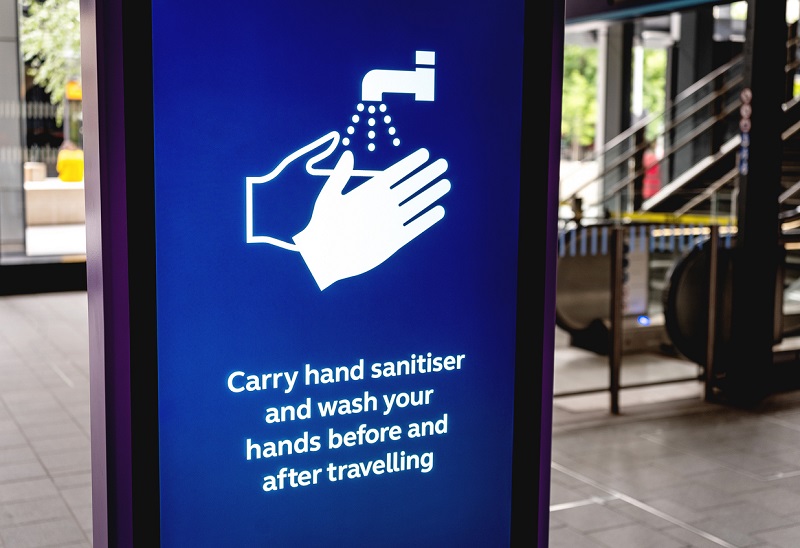 Interactive signage can be amazingly versatile, offering multiple points of interaction, making it a great fit for many environments from shopping malls to office building lobbies.
Interactive signage can be amazingly versatile, offering multiple points of interaction, making it a great fit for many environments from shopping malls to office building lobbies.
Why is Digital Signage Important for Businesses?
Interactive digital signage is designed to be both engaging and attractive. Because of this, it gives companies an incredible opportunity to talk directly to their customers when deployed properly. At the same time, it can offer a range of business insights while capturing customers’ interest and enhancing their overall experience.
Customer Benefits of Interactive Signage
Interactive signage can offer a wide range of benefits to customers and other users, including:
- Speed: The newest interactive signs are as fast as modern smartphones
- Ease of use: Most users own smart mobile devices, and are comfortable with touchscreen technology, making interactive signage easy for them to engage with.
- Accessibility: For customers with disabilities, interactive signage can create more equitable environments via accessibility features, like screen readers and large font options.
- Efficiency: Users are more able to “serve themselves” when interactive signage is available, and have less need to wait on assistance from an employee.
- Entertainment: Engaging content can help keep customers in-store for longer periods of time.
- Education: Digital signage is a great communication tool that can be used to educate users on everything from new products to their immediate environment, leading to a more positive customer experience.
Business Benefits of Interactive Signage
While there are many benefits to customers and other end-users, it’s safe to say that there are equally as many benefits to the companies that deploy them, including:
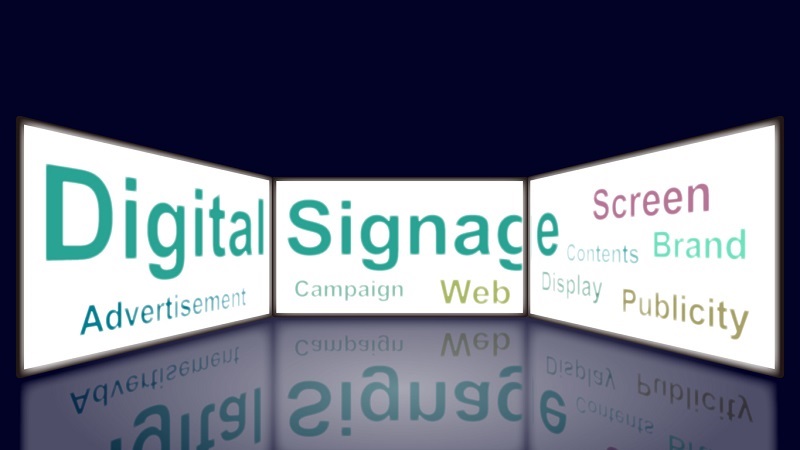
- Increased engagement/attention: Interactive signage can offer more opportunities to entertain and educate customers, as well as extend the amount of time they are in-store. It also makes for a memorable customer experience.
- Cost savings: While customer service attendants are a wonderful resource for complex issues, for simpler things, interactive signage may be just as effective, as well as being less expensive.
- Additional revenue: Digital signage can be used to display paid advertisements from other, related companies that don’t compete directly with the business itself.
- Flexibility: Available in a range of sizes and configurations, these signs can find a home in almost any environment
- Easily updated: Remote updating of content and software updates make interactive displays an excellent conduit for fresh, relevant information.
- Better customer experience: Customers are comfortable with touchscreen technology. At the same time, offering interactive signage gives businesses an opportunity to burnish their company or brand as a modern player in their space.
- Data collection: Digital signage can include software that tracks metrics like usage, as well as collecting customer feedback.
Types of Interactions Possible with Digital Signage
The original and still most common type of interactive signage is that configured with a highly-sensitive touchscreen. Touchscreens allow users to browse or search the display’s integrated database for information. These digital signs are very popular in office buildings when used as directories or for wayfinding. Similar use cases are common shopping malls, too.
QR Codes
QR codes let customers or visitors use their phones to scan information directly to their mobile devices. These codes can prompt everything from review collection to app downloads. They are especially useful for the mobile hand-off of wayfinding and directional information to users’ phones, and are commonly used in smart city kiosks.
Speech Detection and Recognition
Some interactive signage is equipped with passive microphones, much like an Amazon Alexa or Google Home device. This allows the signs to activate the listening functionality with certain keywords or phrases are used, making them usable even without the need to touch or otherwise physically manipulate the displays or integrated components. Speech detection can be an extremely useful feature in terms of accessibility, especially for those who may speak but not be able to write in the primary language used by the display, or for those who are blind or have limited sight. These displays make very helpful additions to government buildings, like courthouses, or college campuses.
Motion Tracking
This is probably the coolest looking but least common type of feature available for interactive signage. Essentially, the sign is enabled with components and software that allow the user’s gestures to be followed or “tracked,” thereby triggering various functionality. While not found in many places just yet (the technology is still very much a work in progress in most places), it could eventually be an interesting addition to signage that features games or other types of entertainment apps, like those in shopping centers or in retail stores.
Facial Detection & Recognition
Facial detection has many different uses, and is mostly used to secure accounts and limit access to them to only those who are approved to use them. Apple’s Face ID is a form of facial recognition that is used to secure their proprietary mobile devices, like iPhones and iPads. This technology also has other interesting applications. For instance, fast food restaurants are beginning to test facial recognition in their loyalty programs to quickly allow users to place orders at self-payment kiosks, when they are ordering a meal that has been categorized as a “favorite,” and instantly collecting payment via a pre-connected account.
RFID and NFC
While most people associate RFID and NFC technology solely with the ability to process payments, both are capable of much more than that. At their core, both RFID and NFC tech are simply ways of delivering information or triggering an action. So while they are probably most commonly used for payment applications, they can also be used to transmit informational downloads, like museum maps, deliver product guides and instructions in retail environments, or connect wireless devices to one another within a household.
Beacons
Beacons are poised to be the next big thing in location-based marketing. While they are quite a basic technology – just a simple, wireless transmitter – it’s less the hardware itself that is making waves, and more its various uses. Beacons help businesses optimize their advertising outreach by allowing them to gather better data and offer more useful promotions via proximity marketing. Users’ mobile phones pick up the beacons’ signals, letting advertisers know where their customers are at a given point in time. Examples of successful beacon use are not uncommon, but are especially prevalent in retail environments, where companies use it to target their ads to customers who they know are visiting or have visited their locations, and better tailor their offers to them.
Mobile Phone Interactivity
Mobile phones are used in most of these examples for one reason or another, but they can also be the place where the interactivity actually occurs. For instance, some companies have used mobile-first websites to host interactive games. These can be played directly on the device, and offer the ability for huge numbers of people to play the games together, creating a sense of community and connection between brand loyalists and the brand itself.
Augmented Reality
Those who use Google search may have recently encountered a new feature that allows users to get up close and personal with…wild animals. No, this isn’t a joke, but it is a neat example of a company using AR to engage with its customers. If a user happens to search for one of a specific selection of animals in its database (and even some fantasy creatures, like unicorns!), Google then asks the user if they’d like to see it in their current environment. They can then choose to view the animal wherever they’re at, via their mobile device, but in their personal surroundings, whether in their living room or in the middle of Times Square.
How to Deploy an Interactive Digital Signage Program
Developing and deploying an interactive digital signage kiosk or program might seem like a huge project, but there are ways to make the process simpler.
- Understand the KPIs: Important to know exactly what needs are to be met with the sign. For example, will it simply display information, or is it intended to to increase revenue?
- Find an experienced kiosk manufacturing partner: There are many companies that build kiosks, but not all of them are able to provide every service or type of kiosk required by a given project. Ensure that the manufacturer selected has experience building and deploying the type of kiosk needed for the project.
- Design the Sign: Turn-key interactive signage manufacturers like REDYREF are able to provide assistance from kiosk design and manufacturing, all the way through its deployment and servicing.
- Deploy Kiosks: Most companies prefer to utilize manufacturers that are capable of not just shipping and delivery, but also set up and training.
- Measure Results: Digital signage can be equipped with software that allows for remote reporting of key metrics, in particular, the KPIs identified at the project’s inception.
Why Choose REDYREF for Interactive Signage
With more than 100 years of experience as a leading American kiosk manufacturer, REDYREF knows how to build interactive digital signage for any environment. From touchscreen information signage and payment kiosks to wayfinding and ticketing, REDYREF is able to create the best and most efficient kiosk solutions on the market. Curious to learn more? Request a quote online, or call 1.800.628.3603 for additional information.
While traditional, analog building directories may still exist, the majority of businesses – of all sizes and across industries – have made the switch to digital solutions. Given their broad utility, attractive design and reasonable pricing, it’s easy to see why digital directories have become so popular over the past five years.
What is a Digital Directory Board?
Digital directory boards help visitors, employees, customers and guests locate specific areas of a building or campus. This can include a wide range of locations – mall stores, businesses within a commercial office building, airport terminals and gates, conference rooms, or the offices of various individuals, such as employees or team members, for example.
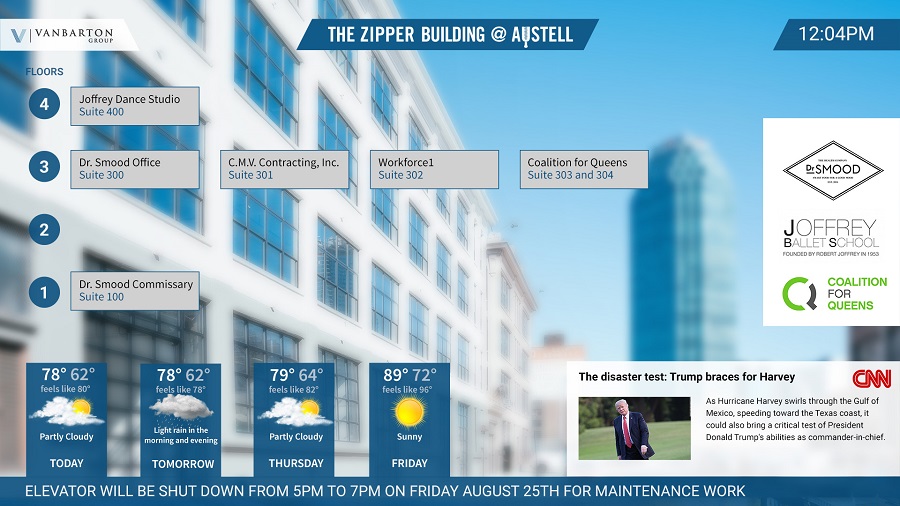
What Types of Digital Directories are Available?
Digital directories are available in several styles, some more complex than others.
- Non-Touch Static: These digital directories display the same information at all times. They are common in office building lobbies, where they show a list of offices, usually by business name, alongside their location, like floor and suite number.
- Non-Touch Dynamic: These digital directory boards are not interactive but they are able to display more information by rotating through a set number of pre-programmed screens. While they most often show typical directory information, screens can also be added to display weather, traffic and news, too.
- Touchscreen and Interactive: Digital directories that can be manipulated by the user are the most expensive, but also offer the most utility. They also offer greater opportunity to capitalize on the larger investment via avenues such as paid local advertising.
Which Businesses can Benefit from Digital Directory Boards?
Digital directories can be found in any number of environments. Some of the more common places they appear are airports and other transportation hubs, hospitals, shopping centers, judicial complexes/justice centers, office buildings, and college campuses.
- Office buildings: Digital office building directories are usually located in the lobby, and depending on the size of the building, are sometimes available on each floor.
- Healthcare: Large hospital campuses can benefit from digital directories to help patients feel more comfortable and less anxious about finding their way around a new place.
- Schools: College campuses were some of the earliest adopters of digital directories. Given they are some of the only places around that regularly “turn over” ¼+ of their population, it’s easy to see why they would be needed.
- Judicial complexes and justice centers: In larger cities and county seats, judicial complexes can be enormous, as well as confusing to navigate. And, for the vast majority of visitors, it’s likely their first (and hopefully, last!) time on the campus, which means there’s unlikely to be enough time for them to familiarize themselves with their surroundings well enough to become comfortable with them.
- Transportation hubs: Airports have quite a range of different locations that travelers may need to find. It’s not just gates, but instead, restrooms, lost luggage, baggage claim, airline assistance, restaurants and stores, too.
Where can a directory board be placed?
One of the many benefits of digital directories is that they are available in many different sizes and able to be placed almost anywhere:
- Movie Theaters: Cinemas can use digital directories to display which movies are playing and what times, as well as the specific theater each film is playing in. They can be placed both at the ticket booth, and inside the lobby.
- Malls: Shopping centers utilize directory boards to display store locations at regular intervals within the building. They are most often hung from ceilings at a level that is eye-catching but unobtrusive.
- Bus Stations: Transportation centers use digital directories to help passengers locate the correct bus terminal, as well as arrival and departure times. They can be located at ticketing areas, as well as at each terminal.
- Hospitals: Healthcare campuses often use directory boards in multiple areas to help assist visitors in finding departments, offices and individuals, as well as common areas like cafeterias and gift shops. They are usually placed wherever there is heavy foot traffic, such as by elevators or in lobbies.
7 Main Benefits of Interactive Digital Directory Boards
While digital directories that are configured with touchscreen, interactive capabilities may be more expensive, the range of benefits available can make them well worth the higher price. Some of these include:
1. Customizable messaging: Messaging can be updated regularly in order to keep it relevant and useful to its intended audience. In environments like hotels or conference centers, for example, digital directories can be used to communicate information about events and meetings, even when they change frequently from day to day.
2. Better user engagement and attention: Interactive digital directories are far more modern and attractive than their analog counterparts, leading to better and more user engagement. They are a simple way to help update and modernize a range of spaces, in particular, office building lobbies.
3. Ease of updating and scheduling: Because digital directories are computerized, they can be easily updated remotely, and new content scheduled to be pushed out on a regular basis. Colleges and universities utilize this feature frequently in order to help students and staff identify classrooms and lecture halls, especially when spaces are shared and users change frequently.
4. Effective in emergency situations: In the case of an extreme weather event or area safety lockdown, digital directory boards, like those found in “smart cities,” can be used to quickly broadcast emergency information.
5 .Helpful for wayfinding and navigation: Interactive digital directories can be integrated with software that allows them to be used for wayfinding and navigation, including turn-by-turn instructions, mobile handoff, and lighted paths. Large educational campuses, in particular, often find this type of utility helpful for directing new students and visitors to their destinations.
6. Revenue generation: Digital directories can be used as an additional revenue source when partnering with local and national businesses to display paid advertisements. Shopping centers are one of the most common environments to find directories that are also used to show ads.
7. Branding and Brand Awareness: Digital directory boards can be customized with “wraps” or powder coated with the company’s brand colors and/or logos. Another way to reinforce branding is with on-screen messaging that can be shown on the “attract” screen, interspersed with other screens, or even presented subtly on every screen in the rotation. Nearly every organization that invests in digital directories chooses to take advantage for at least one of these forms of branding, from ball parks to office buildings.
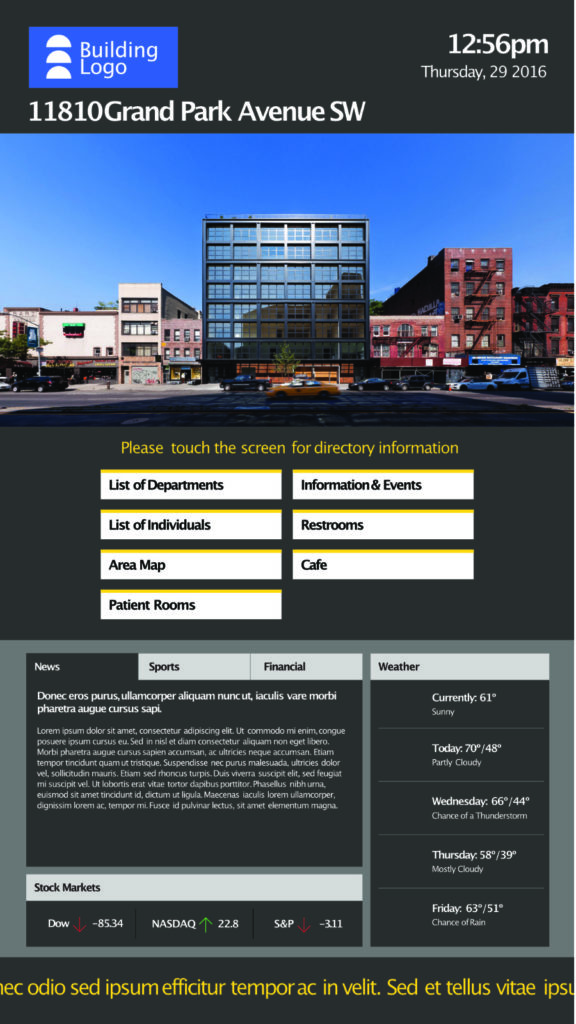
How to create a digital directory board for your business
Digital directories are incredibly popular and can be one of the most affordable types of kiosks to build. In order to get the process underway and have it running smoothly, there are some simple steps to follow:
- Find a reputable digital signage developer and provider: There are many kiosk companies in the digital signage space. However, most are fairly new, and almost none provide turn-key manufacturing services from design to deployment. Choosing a partner who has been in business for many years and can provide end-to-end service, like REDYREF, can help ensure the project’s success.
- Discuss your company's use case for digital boards: This is important because it is what will determine the size and type of display needed, as well as any software, components and integrations required.
- Review the development proposal and quote, as well as any installation or service agreements: Review the proposal and quote, make sure that all of the requested requirements have been met, and don’t be afraid to ask questions.
- Approve proposal for manufacturing: Even if they handle the design and sales aspects of their kiosk programs, most kiosk companies do not manufacture their digital directory boards, but instead, bid them out for manufacturing elsewhere. Companies like REDYREF, however, manufacture their products on-site, and even welcome customers to watch their kiosks being fabricated and assembled right in front of them, whether they are working on a kiosk prototype or full production run.
- Deployment: If an installation or service contract was included in the proposal, the kiosk company will install the digital directory based on that agreement, and will be available to troubleshoot any issues at that time, or in the future. This often includes training staff on how to use, maintain and update the digital directory. As a full-service kiosk solution provider, REDYREF is able to provide all of these options to customers as part of their kiosk manufacturing and service contracts.
Why Choose REDYREF for Digital Directories?
Whether for hospitality, healthcare, educational, or office management needs, REDYREF offers kiosks manufacturing for a range of digital directory designs suitable for every environment. From static digital personnel listings, to interactive maps, weather, stock prices, digital advertising and local area information, our directory software can be customized in hundreds of ways in order meet the needs of our customers. Ready to learn more? Contact REDYREF today by requesting an online quote, or giving our sales team a call at 1.800.628.3603.
Digital signage has become a part of everyday life for most people, simplifying everything from buying a ticket or finding their way in a new environment, to providing an entertaining break from reality via interactive games. Below are some of the benefits of commercial digital signage displays and how they can enhance user experience at malls, in “smart cities,” at hospitals, or even while waiting at the bank.
What is a Commercial Signage Display?
A commercial signage display refers to any display that is intended for use in a commercial environment. They are generally used to communicate with consumers or educate them on any number of topics, from public health information to new product launches from various brands and companies.
More complex commercial signage displays are sophisticated enough that they have been built and programmed to grab their audience’s attention with interactive games , some even utilizing augmented reality, that double as promotions. There are even digital displays that are integrated with various components to allow transactions, such as purchasing and payments or dispensing of goods.
Why is Commercial Digital Signage Important?
Digital signage is important as it can be a powerful tool in influencing consumer behavior. When utilized well, it can enhance brand perception and awareness, increase sales of products or services, and assist with various tasks such as wayfinding and navigation when placed in environments such as malls, transportation hubs, or “smart city” centers.
Additionally, commercial digital signage is built to be durable, and can be utilized both indoors and outdoors, depending on the model chosen. This means it can withstand extremes in temperatures, as well as wind, rain and snow. It is also easy to update frequently, or whenever needed, as these tools are accessed remotely via Cloud servers, and available 24/7.
10 Examples of Commercial Digital Signage
Commercial digital signage is attractive and highly-visible, making it an excellent way to promote multiple products, companies, brands or services, while also providing utility for the end-user, whether to communicate important information or provide wayfinding assistance. Here are some examples of industries that utilize commercial signage.
Malls
Malls implement commercial digital signage for wayfinding, brand awareness, and digital directory purposes. Malls use large digital signage displays to attract visitors as well as provide wayfinding solutions to familiarize them with space. In addition to wayfinding, these displays double as high-tech billboards that showcase a rotating stream of the mall’s current stores, sales and products to those passing by.
Airports
Airports employ digital signage in multiple ways to assist travelers when visiting the airport. The first role of digital signage is to provide a directory and map of the airport. Displays also display flight information, including updates on delays of incoming or outgoing flights, arrivals, and departures, as well as baggage claim information.
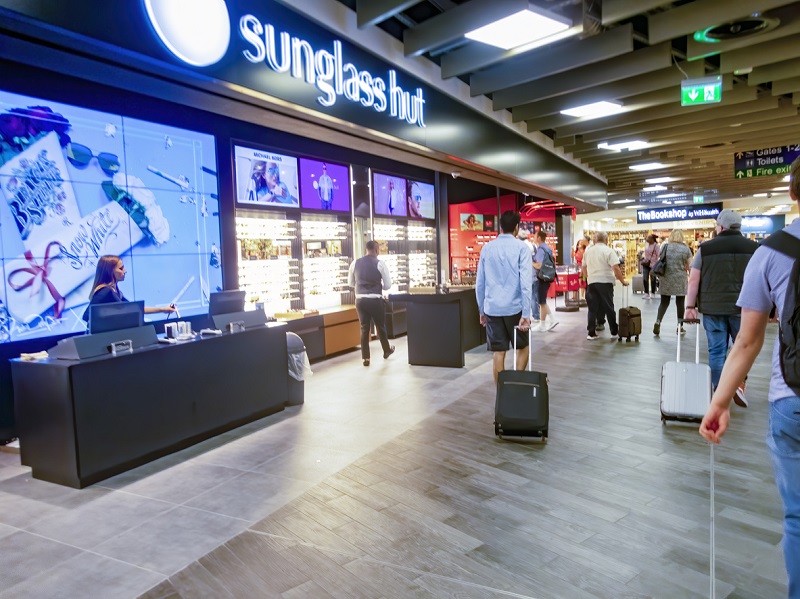
They are also useful at security checkpoints and customs to provide step by step illustrations that help expedite the process by ensuring that passengers have the documentation needed ready, and have prepared themselves appropriately for metal detectors, luggage scanners, or customs agents.
need to empty their pockets beforehand and remove their shoes to expedite the process. Lastly, digital signage can display entertainment, such as trivia, weather, local area information, and news to help passengers pass the time before or between flights more comfortably.
Supermarkets
Supermarkets use digital signage to help promote new products, as well as item-specific sales. This can help increases sales of the new items, or move older products out more quickly in order to make space for others. These displays and kiosks are also able to be built with components that allow them to scan QR codes and print the corresponding coupons or loyalty rewards offers.
Bus Stops
Bus stops employ commercial digital signage displays to provide accurate updates on bus schedules. In addition to providing real-time departure and arrival information, these displays provide an attractive area for advertisements that can reach a wide audience of visitors. Besides advertisements, these displays can also provide local news, weather updates, and area information, helping to occupy and entertain those waiting for the bus to arrive.
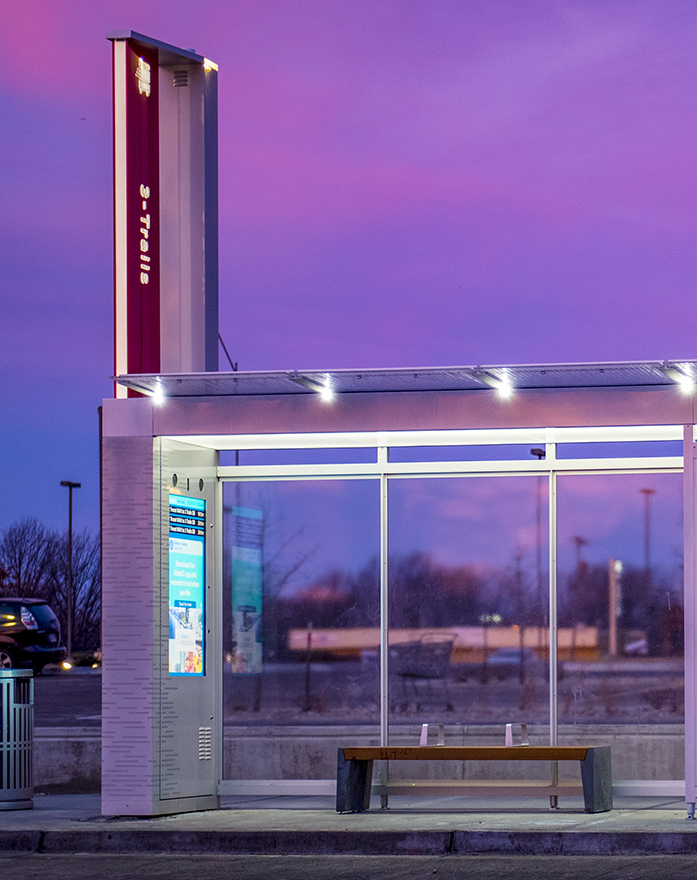
City Centers
Many city centers -- often known as “smart cities” -- utilize digital billboards to promote a wide range of products. Because they see a large number of visitors daily with varying tastes, flexible ad space is a must for these environments. Digital signage displays fill this role by promoting a wider variety of products and services, increasing the chances that what is shown is relevant to a larger number of people. Additionally, they can also provide information on city-wide events, alongside important news and updates.
Healthcare Facilities
Healthcare facilities such as hospitals employ digital signage to assist patients and visitors. Hospital waiting rooms are one example. These often utilize digital displays to provide up to date information about the facilities and wait times, as well as entertainment to help provide a distraction to patients and families while they wait.
These displays are also useful for helping visitors find their way around the facility with maps and interactive navigation. Lastly, these displays provide an attractive ad space, allowing the hospital to promote departments, like medical specialties, and services, like gifts shops and cafeterias.
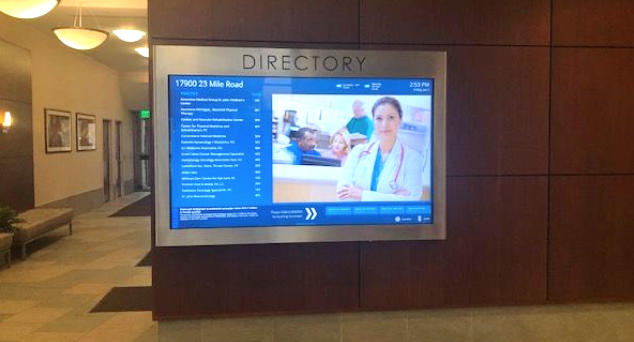
Sports Stadiums and Concert Venues
A prime example of commercial outdoor digital signage is that which is used by many open-air sports and concert venues. Besides displaying information about the game, such as penalties and points, or close-up concert footage that ensures every seat in the house is a good one, these massive screens are also used to convey a wide array of useful information to guests.
They can also display player updates and statistics, information on upcoming games, ticket specials and sports news. These displays are also handy for displaying information about many of the food vendors at the stadium, advertising for businesses large and small, and promoting merchandise for sale from a wide variety of vendors.
Movie Theaters
Large displays at movie theaters are used to showcase new and upcoming releases, as well as display concession menus and ticket specials. Most are also located inside of the theater, but they are sometimes used outside of the theater as well. These displays are often located near the concession counter, using eye-catching animations and videos to promote various food items and make them more enticing to customers.
Banks
Banks utilize digital signage displays to shorten perceived wait times by providing a more engaging experience for their customers. Lines at the bank typically are quite monotonous and tedious, so these displays provide information and sometimes entertainment to ensure that guests are kept better occupied while they wait.
Some banks will display local news, sporting events or weather updates as well. Lastly, these displays will often promote bank services and other available offers.
Museums
Commercial signage displays are a great asset to museums. As museums tend to be large and house multiple exhibits, easy to use and access navigation and wayfinding assistance are a crucial part of a positive visitor experience. These displays provide digital directories for easy navigation, and often offer interactive maps, too. These displays can also be integrated into exhibits, creating more opportunities to interact with and engage guests.
These displays can also be used to showcase promotions like museum membership programs, menu items for the cafe, or specials in the gift shop. Lastly, they can display featured or prominent donors, honoring them for contributions to the museum while encouraging visitors to consider doing the same.
Commercial digital signage provides an essential asset to multiple industries. To learn more about digital signage, visit Redyref today.
Interactive digital signage is quickly changing the way that businesses interact with their customers. An ever-evolving technology, interactive signage provides consumers with more choice, greater freedom, and a more engaging user experience.
Today, let us discuss the ways in which interactive digital signage is evolving and the benefits it can offer to many industries.
What is Interactive Digital Signage?
Interactive digital signage is a type of digital display that allows users to interact with them by either touch or other means, such as a mouse, keyboard or even a mobile phone. Consumers benefit from a more customizable experience, and businesses benefit by gaining greater insight into their customers’ preferences, which then allows them to better design future interactions that fulfill these users’ needs.

Why is Interactive Digital Signage Important?
Interactive digital signage is important as it can be used to deliver a number of different experiences to customers, increasing overall satisfaction with brands, products, and companies. This can include targeted advertising, interactive games, wayfinding, or providing an alternative and often, a more convenient place, to carry out various transactions, such as paying for an item or purchasing a ticket.
The Benefits of Interactive Digital Signage
Interactive digital signage provides an interactive display that can be tailored to fit a business’ needs. As opposed to other forms of signage, interactive signage can help showcase multiple brands, products, programs, and promotions, providing a flexible marketing channel that is easily updated and changed, often making it a more cost-effective option in the long run.
Some of the benefits include:
Enhanced Customer Experience
Interactive digital signage tends to be larger-scale, brightly lit and attractive, allowing companies to easily grab the attention of potential customers. Interactive displays provide a unique opportunity for leaving a lasting impression on a customer as they can interact with it on their terms and create an experience that is tailored to their own desires.
If the experience of using the signage is entertaining and intuitive, it helps burnish a company, product or brand’s reputation. For those customers who prefer to shop without the pressure of a salesperson, digital signage with transactional integrations allows them the freedom to browse or buy without the need for assistance.
Brand Recognition
As customers become increasingly familiar with using interactive digital displays, it helps enhance brand awareness and recognition. Over time, consumers will start identifying the displays and signage with a specific product, company, brand or service. If their experience with the signage has been positive, it can help improve customers’ perception of the business or products, making it more likely they would be willing to return or purchase again.
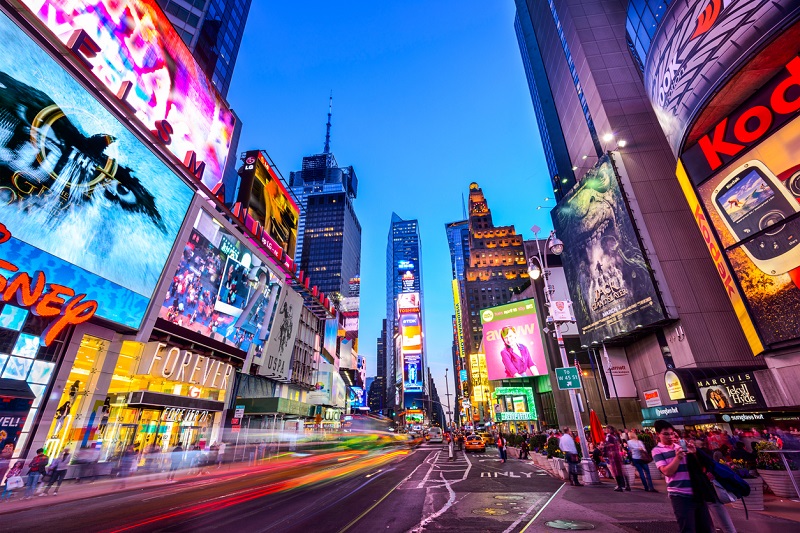
Increasing Brand Trust
Similar to brand recognition, brand trust is essential for creating a positive image. To ensure that brands’ images remain positive, many companies choose to utilize interactive digital signage to reinforce the good that they are doing out in the world by showcasing their work with charities, including charitable giving, or with specific important causes that would resonate with their core customers. This helps create a deeper level of trust between businesses and their customers and increases revenue over the long term due to the same customers’ loyalty.
Promotion/Advertisement
In addition to providing a better user experience, digital signage can help increase awareness of new products, programs, or special offers. As digital signage is large and easy to recognize, it provides an excellent channel to showcase anything new or exciting happening with a company or brand.
Cost-Efficient Dynamic Marketing
With the use of dynamic ad displays, interactive digital signage can be a cost-effective marketing solution, even if it requires an initial investment that is greater than static or paper signage. Dynamic ad displays provide the ability to show a rotating collection of multiple ads that are programmed remotely and stored on a cloud server.
This provides flexibility and also allows businesses to test the effectiveness of different ads. For example, if one ad provides a call to action, suggesting the viewer visit a specific website landing page, and another unique ad for the same product features different ad creative, such as copy and images, and features a different landing page address, companies can then tell which ad was more attractive to consumers, based on the amount of traffic each landing page receives.
Different Ways to Enable Interaction Through Digital Signage Displays
The purpose of interactive digital signage is to create a memorable customer experience while also increasing brand awareness. Below are some of the ways that digital signage can help improve the customer experience.
Touchscreen
Touch screens provide an interactive solution that is easily accessible. Users simply need to touch the digital screen in front of them to access multiple choices. It is for this reason that touch screen signage is employed in so many industries today.
Augmented Reality
Becoming more common today, augmented reality provides users with an interactive reality that can entertain and engage users. This technology utilizes a large camera to map out an area, providing an entertaining augmented space for the user to interact with. This can include taking photos of the user “inside” of the the augmented reality environment.
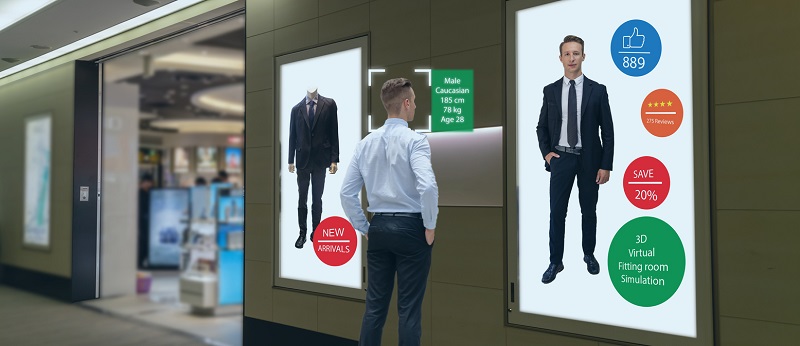
QR Code
QR codes are scanned via users mobile phones, and generally open up a webpage in the phone’s browser. These codes can be used to store additional information that would be difficult to display effectively or attractively in person, such as details about artwork in a museum. They can also be used to create a more engaging experience through activities, such as a scavenger hunt, making the process of discovering them more entertaining.
Gesture Recognition and Human Motion Tracking
Gesture recognition and human motion tracking can be used in advertisements and games. Similar to augmented reality, gesture recognition and tracking can be used to entertain someone and create an engaging, memorable experience while promoting a brand or company.
Social Media
Social media, such as Instagram, Twitter, and Facebook, can provide an excellent, effective platform with which to interact with customers, giving companies greater insight into their wants and needs. An active social media presence can help expand brand awareness even further, especially with the help of social media influencers.
Interactive digital signage improves customer experience, allowing them to personalize their choices. Conversely, understanding customers’ choices allows organizations better provide the customers with better service and products. Creating a more engaging experience via interactive digital signage makes it easier to grow a healthy customer base that is more willing and able to advocate for the products and companies they trust.
For additional digital signage solutions, contact RedyRef to learn more about digital directory and signage solutions.
Conference room digital signage is an invaluable asset for any company. Used to streamline the scheduling process, it can boost productivity and save time, while providing a better experience for employees and their guests. Today we will discuss what conference room digital signage is and how it can benefit your business.
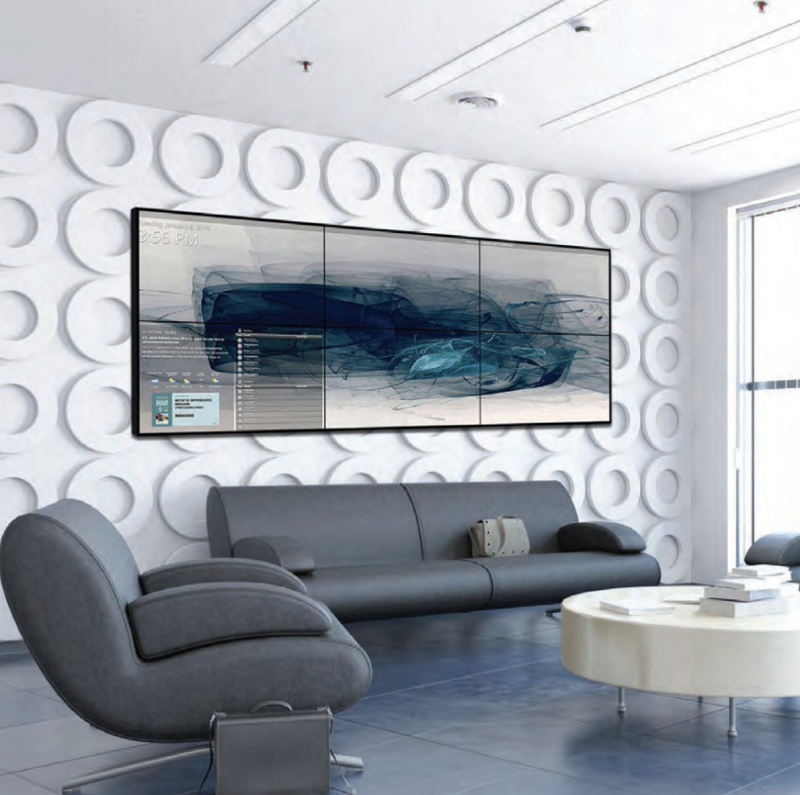
Importance of Conference Room Digital Signage
Conference room digital signage serves a vital purpose in any company that utilizes conference meeting rooms. While it is primarily used as a way to display the conference room’s schedule for the day and upcoming week, it can also be used to welcome guests and visiting organizations, while simplifying some of the logistical challenges that come along with synching meeting schedules around conference room openings. In fact, according to an INC.com article, approximately 65% of the population are visual learners, which means that graphics-based information sharing is often a preferable means for communicating to many people at once.
7 Benefits of Conference Room Digital Signage
Digital conference room signage provides organizations with many benefits, some of which are outlined below.
1) Booking a Conference Room
Digital conference room signage helps to streamline and simplify the process of booking a meeting room. It can easily be integrated with existing calendar systems and provide a streamlined way to view individuals’ availability alongside the room’s. This can help prevent double-booking as well as scheduling conflicts between employees, ultimately saving both time and frustration.
2) Visual Display of Room Availability
Digital conference room signage is able to display up-to-date information regarding the room’s availability in a graphical format outside of the room without disturbing those already inside. This display shows real-time information, so if a meeting is canceled, relocated, or rescheduled, users see the latest schedule, allowing for better transparency and therefore, more efficient utilization of company resources.
3) Better employee and visitor experience
Digital signage provides employees and guests with a better user experience overall. With many check-in solutions available to simplify visitor management, businesses can easily integrate their calendar, conference room and check-in software to streamline multiple systems into one
4) Wayfinding and welcome signage
Digital conference room signage can also serve as part of a larger wayfinding system. Wayfinding is the act of assisting new and returning visitors in familiarizing themselves with their surroundings. Conference room signage outside of meeting rooms can display a meeting room name and number, providing a helpful landmark to assist in orienting new employees and guests. Because the signage is digital and easy to update remotely, these displays are also capable of displaying welcoming images or messages for visitors.
5) Customizable Messaging
Digital conference room signage is customizable, and therefore able to be easily updated for any situation. This is helpful not just to inform as to who currently has the room scheduled, but also to mark celebrations or parties, and even to communicate information regarding emergencies or public health reminders. For example, birthday parties, company announcements, and upcoming event notices can all be displayed as customized messaging with digital signage, making it a more natural and integrated aspect of day-to-day work life.
6) Increased employee productivity
Employee productivity will ultimately increase with conference room digital signage as it helps avoid most scheduling conflicts and simplifies the meeting room booking process. With the ease of use that digital signage brings, an employee can easily schedule a conference room for a meeting or other event without the need to contact every required attendee separately to learn their availability.
7) Space utilization and metrics
For most companies, space is at a premium, so being efficient with the space they have is a must. With digital signage for conference rooms, facilities management and building operations specialists are able to see which rooms are most in use allowing them to better understand how much space is actually needed or used, and how much space is currently underutilized. Ultimately, this data gives organizations a better idea of their space requirements, helping to manage growth while controlling costs.
Digital signage can help many companies grow via greater efficiency and transparency, leading to greater productivity. Conference room digital signage is no different, providing these benefits while offering employees more autonomy while saving them time over the course of their workweek.
Shopping centers and malls today are fast transforming into more modern and complex retail spaces. A major contributor to this is digital signage. Today, digital signage helps to provide mall guests with a better retail experience, helping them make informed shopping decisions, ensuring they can find what they need, and updating them on current events and trends. Digital signage is the future and it helps not only the shoppers but the public's perception of the mall, as well.
What is digital signage?
At its most basic, digital signage is simply a large format, electronic display. Digital signage can be used for many different applications, from QSR menu boards, to local area information like weather and traffic, to advertising and wayfinding. While digital signage is not inexpensive, there are advantages to making the investment due to its overall flexibility in terms of its various uses, and ease of updating.
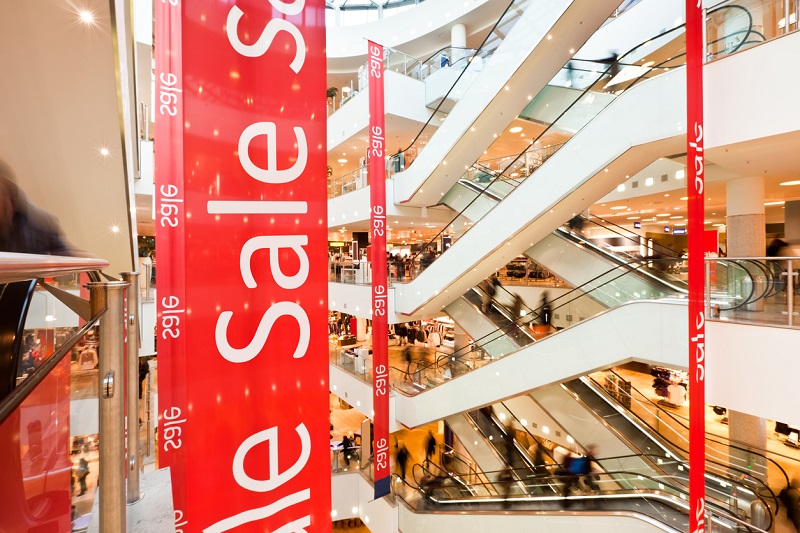
Why is digital signage important?
Digital signage plays an important part in mall and other shopping environments, like lifestyle centers. It can quickly impart a more modern look, while serving multiple, functional purposes, including brand awareness and navigational assistance for shoppers. Because digital signage is bright and easy-to-see, it is also useful to capture visitors' attention when there is limited time in which to do so, such as along their navigational route.
What are the benefits of digital signage in malls?
There are several benefits to having digital signage in malls:
Improved Brand Awareness, On and Offline
Digital signage is a great way to generate brand awareness and grow/engage a brand's online audience as well. Traditional media is limited to a billboard paper sign, whereas digital signage offers the flexibility of multiple advertising and marketing channels, from electronic kiosks to digital signs, all of which can be branded with the company's logo, website address, and social media handles/hashtags.
Enhanced Brand Image
Simple awareness of a brand isn't always enough. Brands also need to be seen as on-trend and changing with the times. Reinforcing key messages that keep brands front-of-mind with their intended audience is a common use of digital mall signage for many businesses from retail to restaurants.
Customizable messaging
One very important advantage of digital signage is how quickly and easily messaging and images can be changed. Most digital signage is simply updated remotely via cloud-based software -- no paper, printing or other hassles required.
Communication and Engagement
Beyond just assisting with brand awareness, digital signage is also an excellent tool for communication, customer engagement, and even data collection. It can easily relay important information and announcements, from weather emergencies to new store openings and sales. Interactive digital signage, like wayfinding, can help provide information for shoppers while anonymously collecting data that can help in tailoring future marketing messages and campaigns.
Examples of Digital Signage in Malls
There are numerous examples of digital signage in malls today:
- Wayfinding : Wayfinding assists both new and returning visitors, allowing them to navigate the space and find the stores or services they are looking for without wasting time. This is done via kiosks with detailed maps and directories, along with helpful iconography.
- Advertisements: Screens and physical kiosks can display ads for any type of product, service, or store for the sake of brand awareness or specific events or promotions like sales.
- News and Entertainment: Kiosks help keep shoppers informed regarding current events or emergency situations, such as extreme weather. Kiosks help to provide news as well as a rotating display of various entertainment clips to keep shoppers entertained during their visit.
- Mall Information: Kiosks also help to provide all the necessary information for a shopper at a mall. This can include business hours, new store openings, or any upcoming events.
Why choose REDYREF for digital mall signage?
REDYREF is a leader in kiosk and digital signage manufacturing and one of the most trusted names in the industry. Our staff works directly with every customer to customize a kiosk that is the right fit for their specific needs, and within their budget. This includes digital signage to enhance mall and other shopping environments. Call us at 1-800-628-3603 or request a quote online today and our sales team will be happy to assist you with your mall kiosk project.
Churches and other places of worship add value to communities in many ways. For instance, they can facilitate communication and understanding between younger and older generations, giving them a place and space to explore a common interest. One way to ensure a comfortable environment for worshipers of all ages is via digital technology that simplifies their visits, and makes them more willing to come back. Digital signage has become a popular choice for many religious facilities due to its multiple uses and applications. Today, we will discuss the benefits digital signage can bring to places of worship and how it can better a community.
What Does Digital Signage Include?
Digital signage provides an easy to read display that prominently displays information of all kinds. Depending on the size of the display, the software chosen, and the various components integrated, digital signage can offer many benefits a range of form factors:
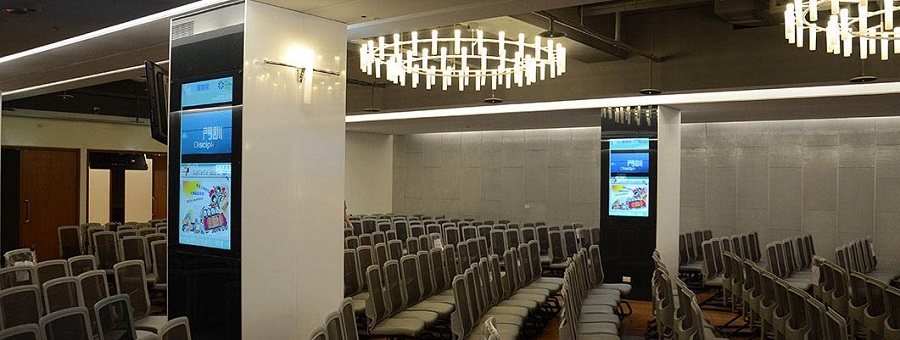
Video Walls: Video walls utilize multiple displays to showcase a variety of information and images. They can be used together to create one large image, such as a photo of an entire congregation. Or they can be used individually to display unique information on each at the same time. For instance, one may offer the ability to search a member directory, another a list of upcoming events and services, a third could show a facility map, and a fourth an inspirational message. They are best placed in areas that receive heavy foot traffic, and can be used both to communicate and beautify a given environment. Utilizing a video wall in this way can help bring a sense of community to any place of worship, including churches, mosques and synagogues.
Transactional Kiosks: Transactional kiosks are a form of digital signage that is integrated with various software and physical components to enhance their interactivity and usefulness. These kiosks can be customized for a wide range of uses, from accepting member donations and printing tickets, to registering/paying for church-sponsored events. Transactional kiosks can be outfitted with components including printers, bill and coin collectors, credit card readers, and signature pads in order to meet these needs.
Wayfinding: Wayfinding kiosks are perhaps the most used form of digital signage, helping visitors navigate larger facilities that may be more confusing, especially to those unfamiliar with the environment. This can decrease stress and ensure visitors are able to make it to sermons, classes, offices, or events on time.
Why Should Religious Facilities Consider Digital Signage?
Digital signage can provide an important asset for synagogues, churches, mosques, and other places of worship, both in building community, and eliminating waste. Digital signage can offer a means to create awareness of the facility and the beliefs of those who attend, which can assist in getting the attention of young adults, something many religions are struggling with at the moment as attendance is declining in many places. It can also make older church members more comfortable by offering a bright, easy-to-read display for those with compromised vision. At the same time, digital signage decreases the need for paper flyers and handouts, eliminating the cost to print, as well as the environmental impact of utilizing unnecessary paper.
What Are the Benefits of Digital Signage?
Digital signage provides many benefits, including:
Direct Communication
Digital signage can provide a large amount of information, even when space is at a premium, to multiple people at once. It lessens the need to have additional personnel on hand to assist visitors and members. Because it can be updated quickly via remote locations, the information displayed is easy to keep up to date, giving everyone in attendance access to the latest news and events.
Customization
Digital signage can not only be updated easily, but it can also be customized for a wide variety of purposes. It makes rotating through different announcements, advertisements from local businesses, and event information -- all in the same place -- possible in a way that paper signage simply cannot match. This also allows any religious facility, from churches to mosques, to communicate a mix of relevant messages based on the specific audience they want to address, making that messaging more meaningful.
Multiple Applications
Digital signage functionality isn’t limited to showcasing simple images because true digital signage isn't simply a nice-looking television. Instead, it includes specialized hardware and software that are purpose-built to handle more than the display of attractive pictures. This means digital signage can be integrated with components to enhance its functionality, including printers, credit card readers, and bill collectors, and software that can handle wayfinding, ticket printing, and event registration.
Branding
The last benefit of digital signage is consistent branding and the ability to communicate messages of pride and inspiration to the church community. Digital signage can provide a clear and concise message that helps to promote the accomplishments of the place of worship's members, staff, volunteers, and religious leaders in a nonintrusive format.

Examples of Digital Signage in Churches
Digital signage is becoming increasingly common in churches and other places of worship, providing an information bank for those who don’t have immediate access to a smartphone or computer. Below are some examples of ways digital signage is being incorporated into religious facilities today.
Religious Holidays/Celebration
Attractively showcasing upcoming holidays and celebrations, as well as photos and images of past events, is one way to utilize digital signage in places of worship.
Bible Study/Classes/Event Organization
Digital signage can help can display the time, date, and location of important events, including things such as bible study, choir practice, and learning opportunities. By providing a consistent schedule that can be viewed digitally, these groups can easily maintain their schedules and make them available to the larger community.
Weddings
Digital signage can be used to display photos of the couple as well as a personal message from them, and information regarding the ceremony and reception, including date, time, and place. This helps create a welcoming environment that is customized for the attendees.
Funerals
Digital signage can be used to display pictures from the life that attendees are there to celebrate, helping to remember them in a positive way.
Bar/Bat Mitzvahs and Other Religious Events
Today, digital signage in places of worship can be useful to help organize and display information regarding important religious events such as bar and bat mitzvahs. They can provide a schedule of events along with location, and display pictures of the person being celebrated. For those that don’t have access to a smart device, digital signage can also make it easy for those to follow along by providing religious texts onscreen so they are able to follow along with the ceremony.
How to Find a Trustworthy Digital Signage Partner
Finding the right company with which to partner to create the right digital signage solution for your school or university environment and purpose can be complicated. Reading reviews, consulting with different manufacturers and doing your own research will all be important to the process. Installation and maintenance of the kiosk or digital signage should also be considered when reviewing options.
Why Choose REDYREF for Digital Signage
Digital signage provides an invaluable service for places of worship and their communities. REDYREF is a leader in kiosk and digital signage manufacturing and one of the most trusted names in the industry. From digital signage solutions for religious institutions and restaurants to COVID-19 temperature taking kiosks, REDYREF manufactures kiosks tailored to all of their customers' needs.



















